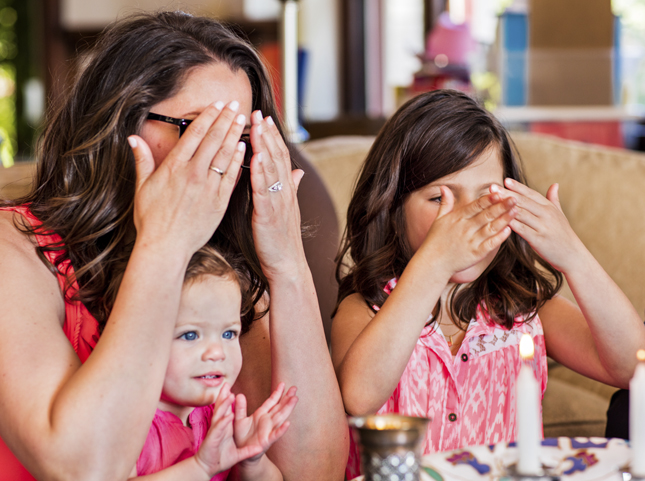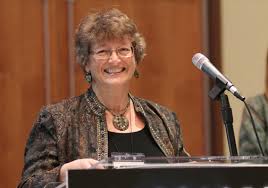Brains, books, & building blocks

Back to basics series
Jewish Family Education with Candace R. Kwiatek, The Dayton Jewish Observer
Harvard University’s extensive review of neuroscience and behavioral research on early brain development offers three unsurprising but significant findings. The brain is most flexible, or “plastic,” early in life. Brains are built over time, from the bottom up. And interaction between genes and experience shape the developing architecture of the brain (InBrief: The Science of Early Childhood Development).
While the first two findings are self-explanatory, the Harvard document offers an intriguing description of the connection between interaction and brain architecture.
It reports that “a major ingredient in this developmental process is the ‘serve and return’ relationship between children and their parents and other caregivers…”
Children are programmed to seek interaction. When the child cries, gestures, or asks a question and the adult responds appropriately, the ping-pong-like back and forth builds and strengthens neural connections in the child’s brain, providing the foundation for further cognitive and emotional growth.
How can these findings inform us about cultivating Jewish identity and menschlichkeit (humane personhood)? For one, the plasticity of young brains suggests that connections to Judaism more easily take root in a child’s early years.
Furthermore, the bottom-up architecture of the brain underscores the significance of the early years in creating a foundation for subsequent Jewish maturation.
Finally, children’s inborn need for interaction makes them active participants in the development of their own Jewish identity and expression of menschlichkeit.
What is particularly remarkable about these modern scientific conclusions is how in tune they are with Judaism’s ancient wisdom.
Children are the building blocks of the future. Rabbinic lore recounts that before God gave the Torah at Sinai, He asked for guarantors to insure it would never be forgotten.
Rejecting Israel’s suggestions of ancestors and prophets, God finally agreed to the people’s offer of their children as its guarantors, (Shir haShirim Rabbah 1:4:1).
Why children? The Torah itself answers in Moses’ final speech to the Israelites. He mandates that the routine public reading of the Torah include children, because when they hear, learn, and observe the Torah’s teachings, “it shall not be forgotten out of the mouths of their seed (Deut. 31:10-12, 21).”

Echoing the research on brain development, Jewish learning in the early years provides a solid foundation for building Jewish identity and a Jewish future.
The significance of parent-child interactions can also be recognized in a biblical text, later incorporated into the Shema prayer: “Take to heart these instructions with which I charge you this day. Impress them upon your children.
Recite them when you stay at home and when you are away, when you lie down and when you get up. Bind them as a sign on your hand and let them serve as a symbol on your forehead; inscribe them on the doorposts of your house and your gates (Deut. 6:6-9).”
Designed to be both formal and informal experiences throughout the day, these varied actions — impress, recite, bind, inscribe — become stimuli for the serve and return exchanges that shape the Jewish architecture of the brain.
Clearly, the Bible was ahead of its time in recognizing the significance of early parent-child interactions in an adult’s Jewish identity and engagement.
Children are unique participants in their own creation. Long before philosophies of “knowing” — strategies for learning styles, and brain-imaging technologies became popular — Judaism asserted the uniqueness of every child and the importance of responding accordingly.
Jacob’s blessings were individually tailored for each of his sons. The Book of Proverbs advises to “Train a child according to his way.”
And Rabbi Nachman of Bratslav explained, “Every Jewish child has a nigun miyuchad, a unique melody. The job of parents is to nurture, cultivate and fully develop that unique melody.”
This ancient but very sophisticated understanding that each child has a unique set of gifts, challenges, and personality traits also implies that the child is an active participant in his or her own identity development.
This perspective is reflected most famously in the Haggadah’s parable of the Four Sons: the wise, the rebellious, the simple, and the silent.
Each in turn poses a question to which the parent responds according to the individual child’s nature and abilities.
“Parents are meant to share their Jewish identity with each child ‘according to his or her intelligence,’ background, age, personality, attitude, and learning style, the Talmud teaches,” writes Rabbi Jason Miller in the article Making the Four Children Speak to Us on Passover. This connects parents and children as partners in the development of identity and expression of menschlichkeit.
The Harvard study’s scientific conclusions about the brain are a modern confirmation of 2,000 years of Jewish wisdom recorded in the Bible, Talmud, and Haggadah.
The message for Jewish parents, in the words of Anita Diamant, author of How to Raise a Jewish Child, is that it’s never too early to pay attention to “the ways we nourish the Jewish self — or soul — in our care.”
And perhaps as we nourish our young ones, we will find that we are nourishing our own Jewish souls as well.
Literature to share
Tucson Jo by Carol Matas. Still the Wild West in the late 1800s, Arizona comes alive through the eyes of the lively and independent teen, Jo Fiedler. Her father’s law-and-order campaign to become Tucson’s mayor stirs up the family and the town, introducing themes of antisemitism, gender equality, and Jewish identity. A quick, excellent read from an acclaimed author, this drama-filled historical fiction based on a true story is targeted to middle grades and young adults.
The Gratitude Diaries: How a Year Looking on the Bright Side Can Transform Your Life by Janice Kaplan. Filled with engaging anecdotes, advice, and thought-provoking research from philosophers, scientists, and scholars, The Gratitude Diaries traces the author’s exploration of the impact of gratitude in every aspect of life. The simple solution Kaplan devises for becoming a more glass-half-full person — regularly listing three things for which she is grateful — significantly increases her happiness while having a powerful and inspiring ripple effect on everyone around her.
To read the complete August 2016 Dayton Jewish Observer, click here.


